Seq2Seq with Attention
Seq2Seq Model

-
It takes a sequence of words as input and gives a sequence of words as output
-
It composed of an encoder and a decoder
-
Machine Translation, Chat bot
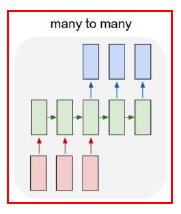
-
decoder의 첫 time step에 'SOS'(Start of String) 라는 토큰을 입력으로 주고 는 Encoder에서 출력된 를 사용한다. 출력값으로 'EOS'(End Of Sentence)가 출력되면 종료한다.
-
LSTM의 각 hidden state 벡터의 차원은 고정되어있는데, sequence가 길어질수록 처음 정보는 점차 유실될 수 있다. 예를 들어, 가 3차원 벡터라면 3차원 공간에 과거의 모든 정보를 담아야 하기 때문에 정보가 점차 유실된 다는 것이다.
'I go home.' 문장을 번역하려고 할 때, sequence가 길어지면 I의 정보가 유실되어 '나는' 이라는 출력이 안 나올 수 있다. 이런 문제를 해결하기 위해 'home go I'처럼 문장을 뒤집어서 입력으로 주는 시도도 있었다.
Seq2Seq Model with Attention
-
Attention provides a solution to the bottleneck problem
-
Core idea: At each time step of the decoder, focus on a particular part of the source sequence.
핵심 아이디어는 각각의 time step에서 출력된 결과는 가장 최근에 입력된 벡터를 가장 잘 반영하고 있다는 것이다. 그래서 각 hidden state의 결과를 종합해서 decoder에서 활용해보자는 아이디어이다. -
https://google.github.io/seq2seq/
위 링크를 들어가면 Attention이 sequence에서 어떻게 적용되는지 확인할 수 있다.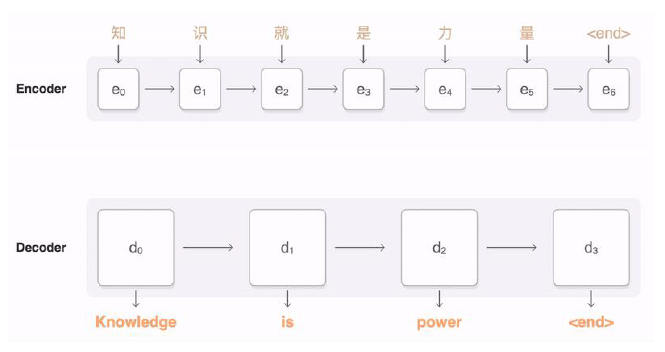
-
Use the attention distribution to take a weighted sum of the encoder hidden states
-
The attention output mostly contains information the hidden states that received high attention
-
Decoder에서 나온 hidden state 벡터를 encoder의 각 hidden state와 내적을 하고, softmax를 통과시킨다. softmax를 통과해서 얻어지는 벡터는 attention vector라고 부르며 이 때 얻은 가중치 벡터를 이용해서 hidden state 벡터들의 가중평균을 하여 Attention output을 얻는다. decoder의 output과 가장 연관이 높은 encoder의 hidden state를 찾는 과정이라고 생각할 수 있다.
-
Attention output은 context vector로도 부른다. (맥락에 대한 정보를 포함)
-
Concatenate attention output with decoder hidden state, then use to compute as before
Attention ouput 벡터와 decoder의 output vector를 concat 시켜output layer의 입력으로 사용한다.
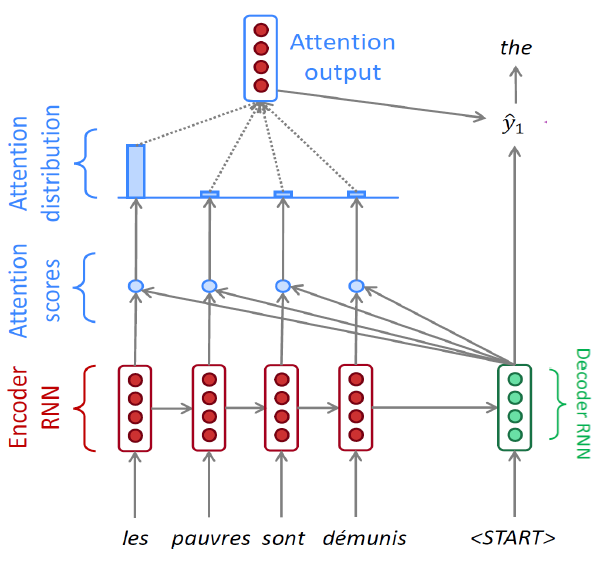
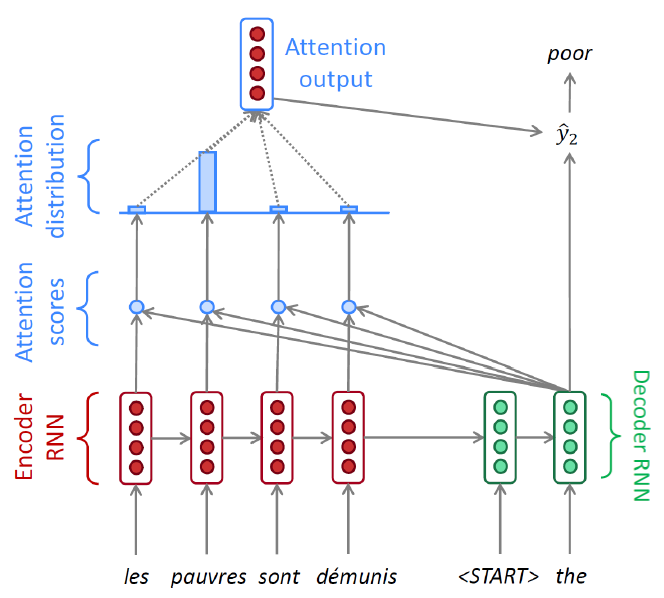
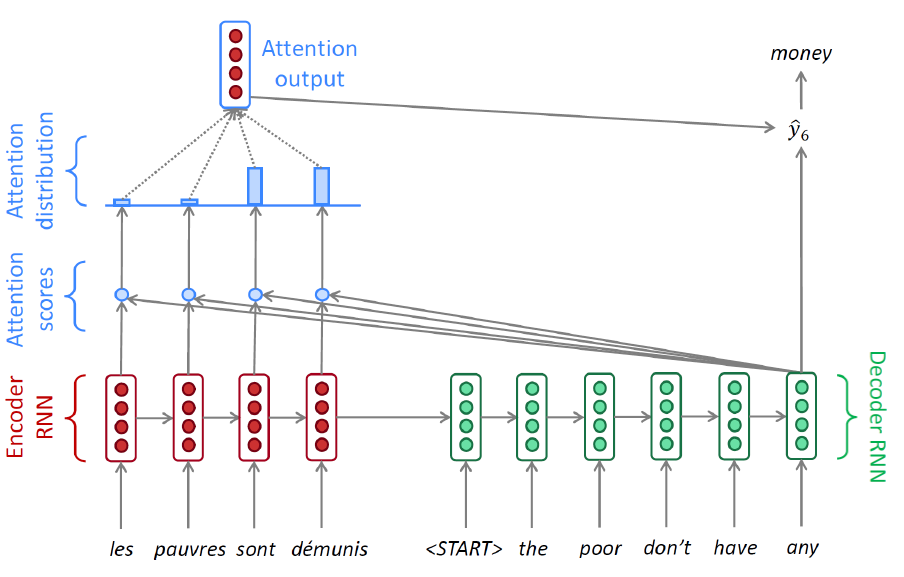
- 학습할 때 Decoder를 살펴보면 <start> 입력을 받은 RNN의 출력을 다시 다음 RNN의 입력값으로 넣어주는게 아니라 ground truth인 the를 넣어주는데 이를 teacher forcing이라고 한다. 항상 정답을 매 입력마다 넣어주기 때문에 실제 상황과는 다르기 때문에, teacher forcing을 통해 학습을 하다가 예측이 정확해지면, tearch forcing을 사용하지 않고 학습을 진행한다.
Different Attention Mechanisms
기본적인 내적
end to end learning
가공하는 과정도 학습시킨다.
-
같은 차원, 다른 차원 끼리의 곱과 그 가중치를 더한 내적
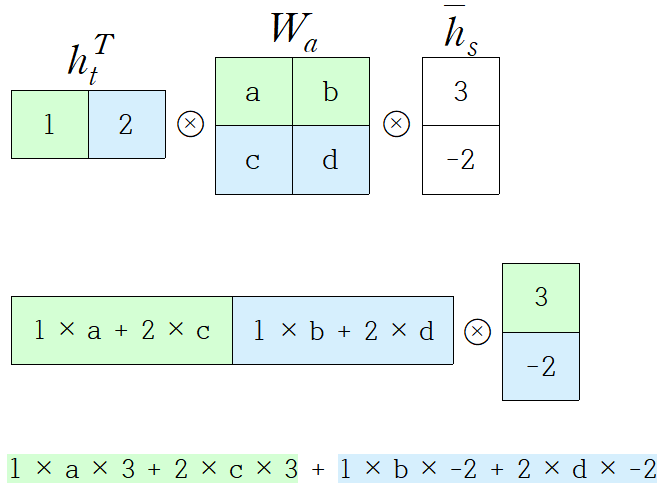
-
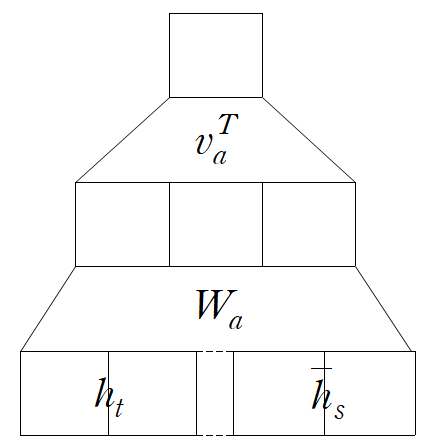
Attention의 장점
-
Attention significantly improves NMT performance
- It is useful to allow the decoder to focus on particular parts of the source
-
Attention solves the bottleneck problem
encoder의 마지막 hidden state만 decoder의 input으로 제공하기 때문에 긴 sequence에서는 과거 데이터의 보존이 힘들어 진다.- Attention allows the decoder to look directly at source; bypass the bottleneck
-
Attention helps with vanishing gradient problem
- Provides a shortcut to far-away states

만약 money가 아닌 다른 단어가 생성이 되면 그 결과가 back propagation을 통해전달 된다. 이 때 encoder의 hidden state vector의 초반 time step까지 전달하는 경우 attention이 없다면 decoder의 마지막 time step부터 하나하나 거슬러 뒤로 가야하지만, Attention output을 통해 빠르게 hiddens state로 gradient를 전달해줄 수 있다.
- Provides a shortcut to far-away states
-
Attention provides some interpretability
- By inspecting attention distribution, we can see what the decoder was focusing on
decoder가 encoder의 어느 부분을 더 잘 반영하는지 확인할 수 있다. - The network just learned alignment by itself
- By inspecting attention distribution, we can see what the decoder was focusing on
Attention Examples in Machine Translation
- It properly learns grammatical orders of words
- It skips unnecessary words such as an article
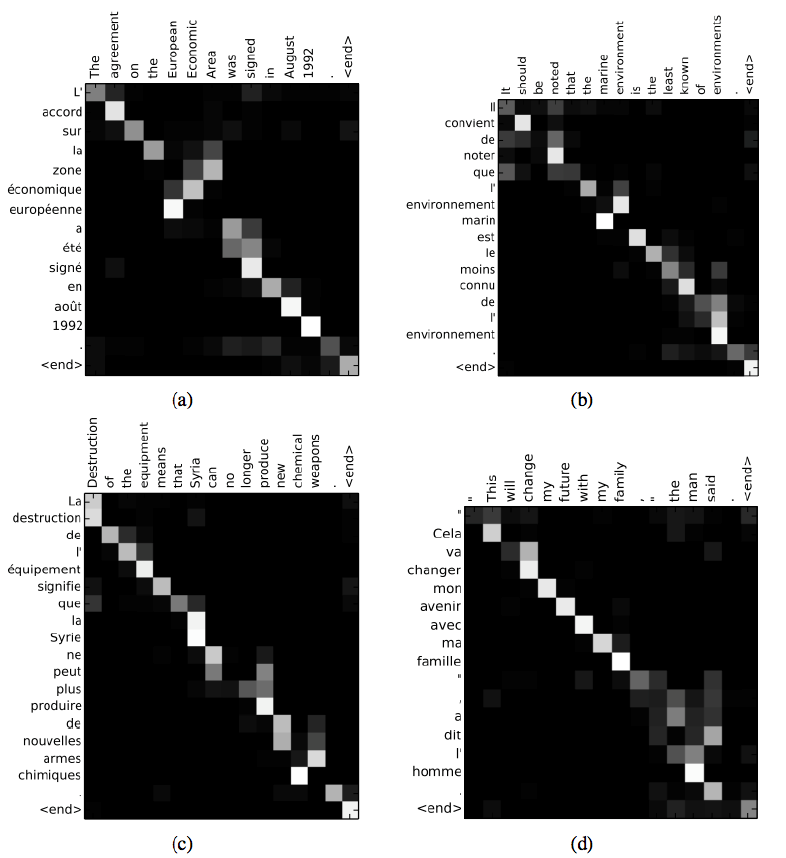
위 그림을 보면 행이 encoder 입력, 열이 decoder의 출력을 나타내는데 각 출력이 encoder의 어느 부분을 참고했는지 확인할 수 있다.
Beam search
-
Greedy decoding has no way to undo decisions!
Seq2Seq with Attention에서는 다음 단어만을 예측하는 task를 학습하고 매 time step마다 단어 중 가장 확률이 높은 것만을 선택해서 decoding을 진행한다. sequence로서의 전체적인 문장의 확률값을 보는게 아니라 근시안적으로 현재 time step에서 가장 좋아보이는 단어를 그 때 그 때 선택한다.- Input: il a m’entarté (he hit me with a pie)
he ___
he hit ___
he hit a ___ (whoops, no going back now…)
- Input: il a m’entarté (he hit me with a pie)
-
How can we fix this?
-
Ideally, we want to find a (length 𝑇) translation 𝑦 that maximizes
- x를 입력 문장, y를 출력문장이라고 할 때, 첫 step의 출력이 으로 나오더라도, 뒤의 조건부 확률의 곱이 작게되면 전체적인 확률 값은 낮을 수 있다.
-
We could try computing all possible sequences
모든 가능한 경우를 확인할 수는 있지만, Vocab size만큼의 연산을 반복 시행하게 되어, 연산량이 기하급수적으로() 커지게 된다.- This means that on each step of the decoder, we are tracking possible partial translations, where is the vocabulary size
- This O() complexity is far too expensive!
Beam Search
Core idea
On each time step of the decoder, we keep track of the 𝑘 most probable partial translations (which we call hypothese)
-
is the beam size (in practice around 5 to 10)
-
A hypothesis has a score of its log probability
- Scores are all negative, and a higher score is better
- We search for high-scoring hypotheses, tracking the top k ones on each step
-
Beam search is not guaranteed to find a globally optimal solution. But it is much more efficient than exhaustive search!

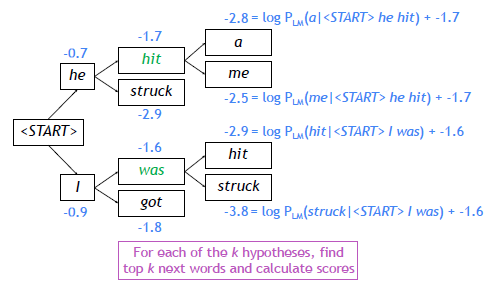
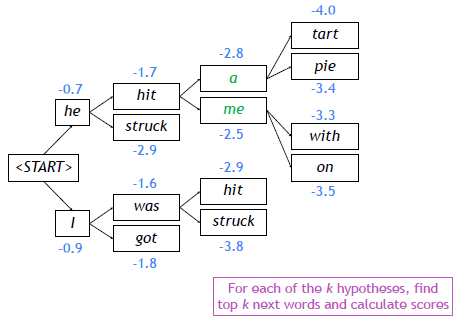
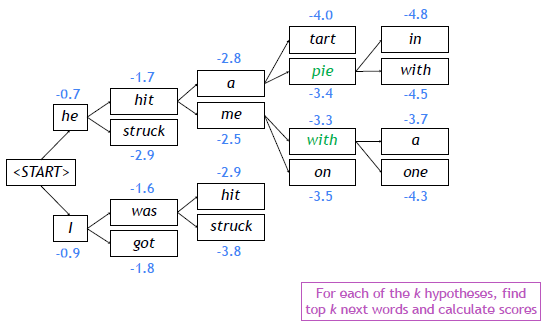
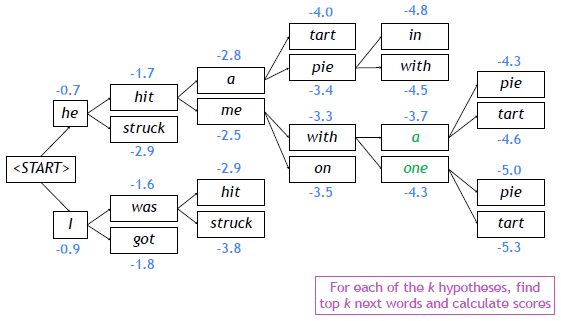
Stopping criterion
- In greedy decoding, usually we decode until the model produces a <END> token
- For example: <START> he hit me with a pie <END>
- For example: <START> he hit me with a pie <END>
- In beam search decoding, different hypotheses may produce <END> tokens on different timesteps
- When a hypothesis produces <END>, that hypothesis is complete
- Place it aside and continue exploring other hypotheses via beam search
- Usually we continue beam search until:
- We reach timestep (where is some pre-defined cutoff), or
- We have at least completed hypotheses (where is the pre-defined cutoff)
Finishing up
-
We have our list of completed hypotheses
-
How to select the top one with the highest score?
-
Each hypothesis on our list has a score
-
Problem with this: longer hypotheses have lower scores
확률은 0 ~ 1 사이의 값이기 때문에 곱해서 log를 취하면, 길이가 긴 sequence일 수록 더 낮은 값을 갖게된다. -
Fix: Normalize by length
BLEU score
Precision and Recall
Reference: Half of my heart is in Havana ooh na na
Predicted: Half as my heart is in Obama ooh na
정밀도
검색엔진에서 검색어를 입력했을 때 검색된 문서 중에 그 내용이 들어간 문서가 얼마나 검색되었는지
재현율
검색엔진에서 검색어를 입력했을 때 실제 그 내용이 들어간 문서 중에 얼마나 검색되었는지
조화평균 더 낮은 값에 가중치를 둬서 평균을 구한다
-
Predicted (from model 1)
Half as my heart is in Obama ooh na -
Reference
Half of my heart is in Havana ooh na na -
Predicted (from model 2)
Havana na in heart my is Half ooh of naMetric Model 1 Model 2 Precision 78% 100% Recall 70% 100% F-measure 73.78% 100% Flaw: no penalty for reordering
BLEU score
BiLingual Evaluation Understudy (BLEU)
-
N-gram overlap between machine translation output and reference sentence
-
Compute precision for n-grams of size one to four
-
Add brevity penalty (for too short translations)
- Typically computed over the entire corpus, not on single sentences
- Typically computed over the entire corpus, not on single sentences
-
기하평균:
I love this movie very much
나는 이 영화를 (정말) 많이 사랑한다.
어느정도 문맥이 맞으면 더 정확하다고 판단하는 precision을 사용한다.
그리고 낮은 값에 가중치를 주기 위해 기하평균을 사용한다. (조화평균은 지나치게 낮은 값에 가중치를 부여한다)
-
graivity penalty:
단순히 길이만을 고려했을 때, ground truth 보다 짧으면 짧아진만큼 precision을 더 낮춰준다.
-
Example
Predicted (from model 1): Half as my heart is in Obama ooh na
Reference: Half of my heart is in Havana ooh na na
Predicted (from model 2): Havana na in heart my is Half ooh of naMetric Model 1 Model 2 Precision (1-gram) Precision (2-gram) Precision (3-gram) Precision (4-gram) Brevity penalty BLEU 0